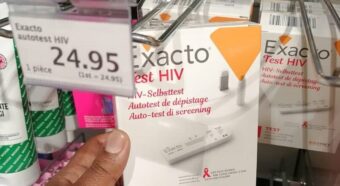Five Reasons HIV/AIDS Has Existed for a Century
- May 10, 2021
- HIV/AIDS
- By Armelle Nyobe
- Read in French

The Silent Pervasion of Dystopia
The 1960s was the era of discotheques, bell-bottomed pants, wild hair, and half-buttoned shirts. Counter-cultural movements gained momentum as individualism became a popular construct. The media was growing in confidence and influence and was touting a new, modern age. There was also turmoil and restlessness in almost every corner of the globe. The west crumbled under the traumatic effects of wars, political systems on all continents shifted and creaked on volatile hinges, and leaders in Africa went head to head with colonialists as the continent’s youthful population cried out for change. According to the African Studies Centre, 1960 was the ‘Year of Africa’ with 17 colonies becoming politically independent.
In the midst of these numerous radical reforms, HIV/AIDS silently infiltrated; its harbinger having taken shape decades earlier in 1920 as a result of Simian Immunodeficiency Virus (SIV) crossing from chimpanzees to humans in Kinshasa, Congo. This first failure to quickly diagnose, contain, and eradicate the disease echoes that of many other pandemics.
The Financial Exploitation of Pandemics
The trajectory of disease often starts slowly before gaining momentum. It is at its initial stages that the biggest opportunities to eradicate it lie. That’s just from a humanistic perspective. Factor in the vapid reality that chaos can be a tool to force social reform, exploit economic markets, and wield class power, and it becomes evident that pandemics wildly running their course represent both the wild fire that destroys and the wild fire that clears the ground for exploitation.
In its 2020 paper titled ‘Power, Profits and the Pandemic,’ Oxfam delivered some stark facts about the world’s most recent pandemic, COVID-19. The Non-Profit Organization stated, “Four hundred million jobs have been lost during this pandemic yet 32 of the world’s most profitable companies are expected to make $109 billion dollars more in 2020 than in previous years. These same 32 super-profitable corporations distributed $1.3 trillion to their most wealthy shareholders in the four years leading up to the COVID-19 pandemic. Since January, they’ve already paid shareholders $195 billion.”
These facts are as shocking as they are painful. Just how profitable are pandemics? And are corporations doing enough to help make a positive difference? According to the Lancet Journal, by 2006, the Global Fund had a funding shortfall of $2.1 billion, which was half of the finances needed for it to continue giving grants in the fight against HIV/AIDS. The journal’s editorial in August of that year was called ‘The Business of HIV/AIDS’ and valiantly gave an account of multiple corporations’ efforts to help raise money for bodies like the Global Fund. Ten million dollars had been raised in four months; a staggering figure for a layman, chicken feed for a group of global corporations.
The Continuous Trajectory of Stigma
By the 1980s, HIV/AIDS wasn’t just a wild rumor. Its existence was a confirmed public fact and most myths around it were debunked. Even then, and despite the education from scientists and public figures, it continued to take on the caricature of a monstrous affliction. Those who had it were ostracized and demonized. Those who didn’t lived in constant fear of catching it. This was the second failure. The societal chatter around HIV/AIDS was as loud as the silence forced upon its victims. For that’s what they were then; victims. We now know better than to label anyone with HIV/AIDS a victim. Yet the question is: What does continual stigmatization do if not victimize?
Millions worldwide have seen, felt, been impacted, and have had their lives irreversibly changed by HIV/AIDS. Though the haunting images of sunken-cheeked, skeletal patients with thinning hair and terror-stricken eyes are largely gone from public media and perception, we still remember because we lived with them. Those were our parents, cousins, aunts, uncles, friends. The sadness and grief is still with us, compounded by either our own HIV positive statuses or that of our family members and peers. And in many homes, hospitals, and hospices around Africa today, the face of HIV/AIDS is still as heartbreaking as it was all those decades ago, and the stigma is just as potent.
Access to ART, Politics of Patents, and Stifled Dialogue
AntiRetroviral Therapy (ART) is the world’s most successful response to HIV/AIDS, but even it comes with its own politics and power plays, often at the cost of the people at the bottom line. Throughout the 2000s, pharmaceutical companies have been embroiled in one scandal or another. Patent wars, pricing anomalies, and shareholder expectation to make profits, are just a few examples of how commercial gain continues to drive what should be a humanistic approach to the pandemic. Biopharmaceutical giant, Gilead Sciences, is currently facing multiple lawsuits for its decision in 2004 to halt the roll-out of a new and improved HIV/AIDS drug, TAF, so that the company could keep profiting off the less effective tenofovir that they already had on the market.
In sub-Saharan Africa, the worst hit region in the world, keeping patients healthy and alive by all means necessary is the top priority. With its focus on cheaply or freely acquiring whatever drugs promise prolonged life for patients, Africa then struggles to participate in the bolder discussions about the commercialization of the pandemic. As the poorest continent in the world, Africa’s seat at any conversational table often comes with limitations.
Still, credit must be given. When used correctly and supported with a healthy diet and lifestyle, ART strips HIV/AIDS of its once abominable power. Millions of people with an HIV positive status now have a viral load so low that it’s undetectable. This is the success but the term is relative. HIV/AIDS has existed for 100 years and has been a public health crisis for 40 of them. That’s too long a time for a tech and intelligence-driven world to grapple with one disease.
Our Monotonous Approach
Daily infection rates are propagated by a long list of factors: Poverty, illiteracy, mental health challenges, abuse, power struggles, cultural norms, all held together by a tight thread of class inequality, shame, fear and secrecy. The cat has to come out of the bag. The skeletons have to tumble out of the closet. The difficult conversations have to be had. We heal and manage our lives better when we finally talk about and face the things we kept hidden.
We have been educated about the MDGs and the SDGs. MDG 6: Combat HIV/AIDS, malaria and other disease. SDG 3: Good health and well-being. These are lines we’ve memorized and every year, symposiums, conferences, talks, workshops, and annual general meetings are held to discuss how far the world has come in attaining its set list of goals. And each year, it is agreed that it hasn’t come far enough; there are gaps and challenges that are still getting in the way of goal attainment. Reports, papers, and articles are shared; each a monotonous replica of presentations from the year before and the year before that.
The honest conversations are not being had. Why has this disease existed for as long as it has? Are global leaders and decision-makers treating HIV/AIDs as a wildfire that destroys or as a wildfire that clears the ground for exploitation? Are local leaders stepping out of their comfort zones and re-strategizing a new approach to the scourge? Are our outreach programs and media campaigns outdated and monotonous?
It’s easy to insert statistics; to paint a horrendous portrait of HIV/AIDS infection rates, death rates and its widespread impact. But horror, we’ve learned, tends to lose its shock value. The world has changed and its primarily youthful residents aren’t moved by statistics any more than they’re terrified by gore on their computer or cellphone screens. Success or failure in rallying this generation to effectively eliminate the spread of HIV/AIDS is largely dependent on the kind of conversations that are being had in boardrooms, conferences, living rooms, bedrooms, laboratories, presidential suites, global summits, classrooms and lecture halls. There is no place or platform that is too small or too big to not facilitate the genesis of conversations that remind us all of our humanity, of the ones we lost, and of the ones we shouldn’t have to lose.
It is time to rewrite a century.
Alice M. Simushi


